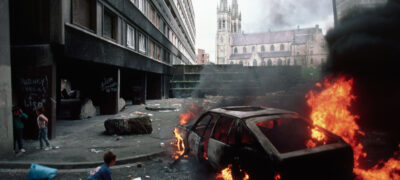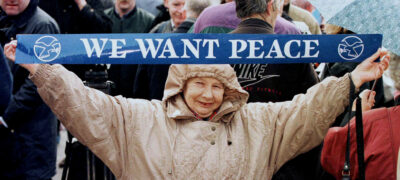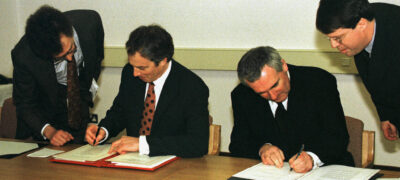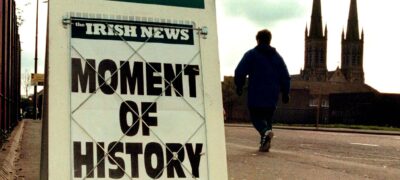The resources on this page have been designed for different levels. Please note, the transcripts of the resources retain any typographical errors included in the original documents.
Key Stage ThreeKey Stage FourKey Stage Five
They are designed to complement our short film and assembly pack ‘From Conflict to Peace – 25 Years On.’ This 7-minute video gives an overview of the conflict and the peace process that brought it to an end, plus details about what the Agreement did and the results of it. This can be used as part of an assembly presentation which should take around 15-20 minutes depending on the amount of time allowed for discussion at the beginning about what students know already about Northern Ireland and the Agreement.
Key Stage Three:
The Road to the Belfast Good Friday Agreement

Why was it so difficult to make peace?
- Explore two key moments on the road towards the Belfast (Good Friday) Agreement.
- Learn about why it was so difficult to make peace.
- Use contemporary documents to deepen your understanding.
72 Hours to the Belfast Good Friday Agreement
 How was peace achieved in the final 72 hours of negotiations?
How was peace achieved in the final 72 hours of negotiations?
- Know what barriers stood in the way of an agreement, 7-10 April 1998.
- Understand how the Belfast (Good Friday) Agreement was finally achieved.
- Use contemporary documents to deepen your understanding.
Key Stage Four:
The Belfast Good Friday Agreement
 What was the significance of the Belfast (Good Friday) Agreement? How can we use the documents as evidence to one of more of the lines of argument?
What was the significance of the Belfast (Good Friday) Agreement? How can we use the documents as evidence to one of more of the lines of argument?
- Explore the significance of the Belfast (Good Friday) Agreement of 1998.
- Examine how historians use sources to develop a line of argument.
- Develop your own line of argument based on your learning.
Downing Street Declaration
 What was the significance of the Downing Street Declaration?
What was the significance of the Downing Street Declaration?
- Explore the significance of the Downing Street Declaration.
- Examine how historians use sources to develop a line of argument.
- Develop your own line of argument based on your learning.
Key Stage Five:
What led to the Belfast Good Friday Agreement
 What was the most important factor which led to the achievement of the Belfast (Good Friday) Agreement?
What was the most important factor which led to the achievement of the Belfast (Good Friday) Agreement?
- Explore what role the key figures in the peace process played?
- Consider if it is possible to argue that there was one key figure or group?
- Explore interpretations from historians
- Test interpretations against historical evidence